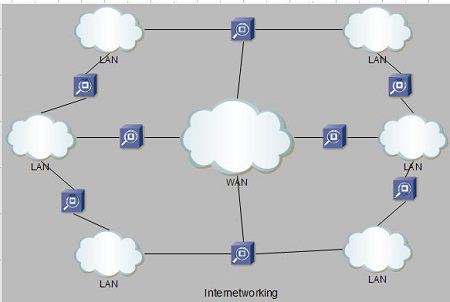Internetworking started as a way to connect disparate types of computer networking technology. Computer network term is used to describe two or more computers that are linked to each other. When two or more computer LANs or WANs or computer network segments are connected using devices such as a router and configure by logical addressing scheme with a protocol such as IP, then it is called as computer internetworking.
Internetworking is a term used by Cisco. Any interconnection among or between public, private, commercial, industrial, or governmental computer networks may also be defined as an internetwork or “Internetworking“.
In modern practice, the interconnected computer networks or Internetworking use the Internet Protocol. Two architectural models are commonly used to describe the protocols and methods used in internetworking. The standard reference model for internetworking is Open Systems Interconnection (OSI).

Type of Internetworking
Internetworking is implemented in Layer 3 (Network Layer) of this model The most notable example of internetworking is the Internet (capitalized). There are three variants of internetwork or Internetworking, depending on who administers and who participates in them :
• Extranet
• Intranet
• Internet
Intranets and extranets may or may not have connections to the Internet. If connected to the Internet, the intranet or extranet is normally protected from being accessed from the Internet without proper authorization. The Internet is not considered to be a part of the intranet or extranet, although it may serve as a portal for access to portions of an extranet.
Extranet
An extranet is a network of internetwork or Internetworking that is limited in scope to a single organisation or entity but which also has limited connections to the networks of one or more other usually, but not necessarily, trusted organizations or entities .Technically, an extranet may also be categorized as a MAN, WAN, or other type of network, although, by definition, an extranet cannot consist of a single LAN; it must have at least one connection with an external network.
Intranet
An intranet is a set of interconnected networks or Internetworking, using the Internet Protocol and uses IP-based tools such as web browsers and ftp tools, that is under the control of a single administrative entity. That administrative entity closes the intranet to the rest of the world, and allows only specific users. Most commonly, an intranet is the internal network of a company or other enterprise. A large intranet will typically have its own web server to provide users with browseable information.
Internet
A specific Internetworking, consisting of a worldwide interconnection of governmental, academic, public, and private networks based upon the Advanced Research Projects Agency Network (ARPANET) developed by ARPA of the U.S. Department of Defense also home to the World Wide Web (WWW) and referred to as the ‘Internet‘ with a capital ‘I’ to distinguish it from other generic internetworks. Participants in the Internet, or their service providers, use IP Addresses obtained from address registries that control assignments.
 Dinesh Thakur holds an B.C.A, MCDBA, MCSD certifications. Dinesh authors the hugely popular
Dinesh Thakur holds an B.C.A, MCDBA, MCSD certifications. Dinesh authors the hugely popular